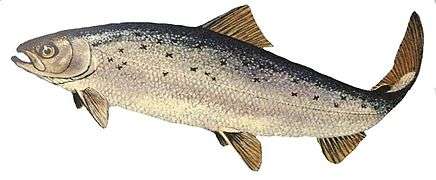Putcher
A putcher is a type of fish trap (especially for salmon) in the form of a conical basket, similar in appearance to a five-foot ice-cream cone. Putchers are placed in rows, standing four or five high, in a wooden "rank" set out against the incoming and/or outgoing tides.[1]
As a method of fish capture, putcher fishing is peculiar to the River Severn in Great Britain and is believed to be of prehistoric design. Traditionally the putcher was made of hazel rods with withy (willow) plait, both materials being grown locally on the Caldicot and Wentloog Levels. Modern baskets made of steel or aluminium wire were introduced in the 1940s and 1950s.
Traditional construction
Willow was harvested using traditional methods of pollarding, where a tree would be cut back to the main trunk. New shoots of willow, called "withies", would grow out of the trunk and these would be cut periodically for use.
To make a putcher by hand, a low bench was used approximately 18 inches (460 mm) high and 24 inches (610 mm) square into which 9 holes were made, in a circle 10 inches (250 mm) in diameter. Green withy or hazel rods were then split into three using an oak cleaver held in the maker’s hand.[2] The split lengths were then inserted into the holes to make a conical shape and a withy ring was plaited round them close to the surface of the bench. Nine shorter rods, either complete or in thirds, were then inserted into the ring, with two more rings being plaited around to secure them, one halfway up and another near the top. A nose ring was then plaited. The putcher was then pulled out of the bench, the nose ring attached and a spiral "worm" was added from the narrow end to the middle.[2] A base ring was woven at the end of the basket. Any longer rods could then be trimmed and the basket was ready for use. The basket was expected to last for two fishing seasons, possibly also for a third following repair.
See also
References
- ↑ Putcher Use in the Severn Estuary
- 1 2 Hando, F.J., (1958) "Out and About in Monmouthshire", R. H. Johns, Newport

